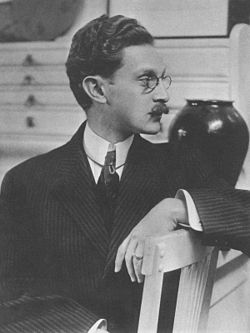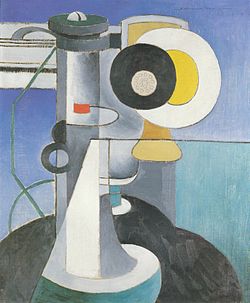- Morton Livingston Schamberg
-
Morton Livingston Schamberg (October 15, 1881 - October 13, 1918) was an American painter and photographer. He was one of the first American artists to explore the aesthetic qualities of industrial subjects.[1] Schamberg is considered a pioneer of the Precisionism art movement, and one of the first American adopters of Cubist style.[2]
Contents
Biography
Early life and education
Schamberg was born in Philadelphia on October 15, 1881.[3][4] He was the youngest child in a German Jewish family.[5] His father was a cattle dealer; his mother died when he was a child.[5]
Schamberg graduated from Philadelphia's Central High School.[3] He earned a degree in architecture from the University of Pennsylvania in 1903.[4] In 1902, however, he had discovered an interest in art when he attended a class taught by William Merritt Chase in Holland.[4] He took another class with Chase during the summer of 1903, in England, and then studied under him for three years at the Pennsylvania Academy of the Fine Arts.[4] It was through Chase's classes that he met fellow student Charles Sheeler, who would be his close friend for the rest of his life.[2]
Career
Schamberg met up with Sheeler in Italy in 1908 and together they studied works of the Renaissance masters.[3] Schamberg moved on to Paris later that year,[4] where he became an associate of Leo and Gertrude Stein's circle of avant-garde artists and writers.[1] Schamberg's earliest works were heavily influenced by Chase.[1] After studying the works of European artists in Paris, however, his style shifted to modernism, with influences from Cézanne, Matisse, and Picasso evident in his works created between 1909 and 1912.[1] He returned to Philadelphia in mid-1909, and he and Sheeler rented studios in the same downtown building as well as a farmhouse in rural Bucks County for use on weekends and during the summer.[3] Around 1912, Schamberg began working as a photographer to earn money, initially as a portraitist before focusing on urban architecture.[3]
Schamberg participated in the landmark 1913 Armory Show in New York, showing five of his modernist paintings.[1][3] By 1915, he began painting mechanical forms, possibly through the influence of Dada artists such as Marcel Duchamp.[1] These late paintings ranged from precise illustrations to variants on Cubist, Fauvist and Futurist styles.[1] The only work credited to Schamberg that reflects a strong Dadaist sensibility is the assemblage God, but this attribution has been questioned by art historians who believe he only photographed it.[3]
Schamberg was a pacifist,[3] and his distress over World War I ultimately caused him to drop the subject of machines to work in watercolors, only one of which has survived: a still life of a bowl of flowers.[2] An associate of art collector Walter Conrad Arensberg, Schamberg exhibited a painting and a drawing in the first show of Arensberg's Society of Independent Artists, in 1917.[4]
Schamberg died October 13, 1918 in the 1918 flu pandemic and was buried on October 15, which would have been his thirty-seventh birthday.[3] He had been living in a Philadelphia hotel with his father, who also died in the pandemic.[5]
Exhibitions
- Paintings by Morton L. Schamberg (1881-1918), Pennsylvania Academy of the Fine Arts, Philadelphia, November 21 - December 24, 1963
- Morton L. Schamberg (1881-1918), Zabriskie Gallery, New York City, January 6-25, 1964
- Morton Livingston Schamberg (1881-1918), Salander-O'Reilly Galleries, New York City, November 3 - December 31, 1982. Toured January 22, 1983 - March 27, 1984, to Columbus Museum of Art, Columbus, Ohio; Pennsylvania Academy of the Fine Arts, Philadelphia; Milwaukee Art Museum, Milwaukee, Wisconsin.
References
- ^ a b c d e f g Roberts, Norma J., ed. (1988), The American Collections, Columbus Museum of Art, p. 90, ISBN 0-8109-1811-0.
- ^ a b c Glueck, Grace (November 12, 1982), "The Pioneering of Martin Schamberg", The New York Times, http://www.nytimes.com/1982/11/12/arts/art-the-pioneering-of-morton-schamberg.html, retrieved September 15, 2011.
- ^ a b c d e f g h i Harnsberger, R. Scott (1992), Ten Precisionist Artists: Annotated Bibliographies, Westport: Greenwood Press, pp. 215-216, ISBN 9780313276644.
- ^ a b c d e f Perlman, Bennard B.; Pach, Walter (2002), American Artists, Authors, and Collectors: The Walter Pach Letters, 1906-1958, SUNY Press, p. 358, ISBN 9780791452943.
- ^ a b c Kramer, Hilton (April 1983), "The Morton Schamberg Retrospective", The New Criterion, http://www.newcriterion.com/articles.cfm/The-Morton-Schamberg-retrospective-6821, retrieved September 12, 2011.
Further reading
- Agee, William C. (1982), Morton Livingston Schamberg, Salander-O'Reilly Galleries, Inc.
- Kramer, Hilton (1985), "Morton L. Schamberg", The Revenge of the Philistines: Art and Culture, 1971-1984, Free Press, pp. 127-131, ISBN 9780029184707.
- Wolf, Ben (1963), Morton Livingston Schamberg: A Monograph, University of Pennsylvania Press.
External links
 Media related to Morton Schamberg at Wikimedia Commons
Media related to Morton Schamberg at Wikimedia Commons
Categories:- American painters
- American photographers
- Modern artists
- Pennsylvania Academy of the Fine Arts alumni
- Artists from Pennsylvania
- People from Philadelphia, Pennsylvania
- American people of German-Jewish descent
- Jewish American artists
- Deaths from the 1918 flu pandemic
- 1881 births
- 1918 deaths
Wikimedia Foundation. 2010.


